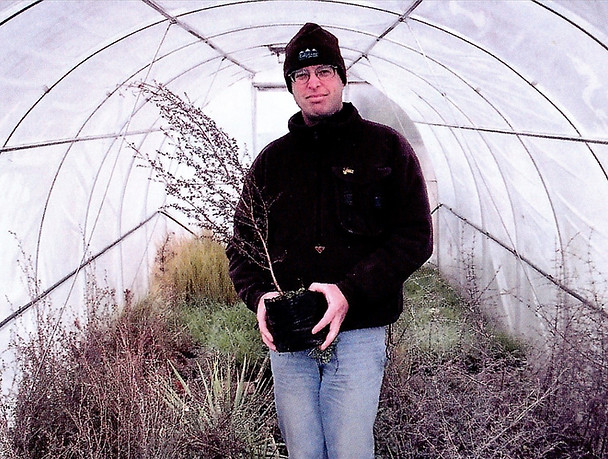
Tim with the direct seeder he's trialling at sites around the South Island.
Tim Whittaker
Trust advisor
“We’ve got very short time horizons. We like to see things happening in years, or ten years, or a decade or two. But nature doesn’t work like that.”
Tim Whittaker has worked for the Department of Conservation on land tenure review for the last twenty eight years. Through both his hobbies and his work he’s been able to pursue two of his passions, botany and land restoration.
“The botany in this landscape drives everything really,” says Tim. “It drives the food resource, and the cover for lizards and everything else. And of course we live in the driest part of NZ, it’s really difficult to establish plants, so that’s been my passion really.”
Twenty years ago Tim started growing his own dryland natives, a thousand or two a year. He planted some at his own place, and sold or swapped the rest. “They’re all around the place now,” he notes.
More recently, in his role at DOC, he has been pioneering the work into direct seeding as a way to regenerate native plants over large areas of the landscape. Trials are suggesting it could provide a more economical way of planting native shrub and forest. This could help more native plantings to be included in projects such as the Government’s one billion trees. “Nature works in centuries, in long time periods” he says, “And that’s something that most people aren’t interested in really.” People expect to see results sooner than this. “So putting seed sources back into the landscape is part of where we should be going. Then they can spread by themselves.”

Coprosma berries at Mokomoko Dryland Sanctuary. Anna Yeoman
Tim has been involved with the Central Otago Ecological Trust (COET) as a trust advisor from very early days. As well as offering his knowledge of botany and landscape, he’s contributed hugely to the technical and problem solving aspects of COET’s work. He was instrumental in designing the system of underground pipes and bunkers that enabled their first captive bred Otago skinks to survive the cold Alexandra winters.
An even bigger project was working on fence designs for Mokomoko Dryland Sanctuary. When COET was considering building a predator proof fence that excluded all mammals except mice, Tim designed and built a number of trial fences. “In the end we had twenty metres of one made and installed in there for a couple of years to see how the snow and the wind affected it.” It was more than five times cheaper than a full pest-proof fence, and it performed well. However, when mice were seen attacking Otago skinks in small fence at Mokomoko Dryland Sanctuary, thoughts of a “leaky” fence were immediately dropped. Happily though, Tim’s work didn’t go to waste, and his design was used by a sanctuary in Southland.
It was more than five times cheaper than a full pest-proof fence, and it performed well.

Tim in his tunnel house with native plants that he raised.
.jpg)
A keen fisherman
Tim has always been interested in animals, and in the outdoors. “I always kept birds. I had everything, everything I could fit in a section at home,” he remembers. He still keeps animals, and gets into the outdoors whenever he can. “I’m a lifetime hunter, and fisherman, and tramper,” he says. In a few weeks he’s going to retire, and the plan is to spend it adventuring in New Zealand, based from the camper van he’s doing up.
After working in New Zealand conservation for several decades, he’s very aware of both the inadequacies, and the risks, of conservation initiatives, including Mokomoko. “In the big scheme of things, you’re only the ambulance at the bottom of the cliff,” he says. “Predator fences are expensive to build, expensive to maintain and have no certainty around them.” He is all too aware that many translocations of animals fail.
Yet he also sees plenty to be encouraged about at Mokomoko Dryland Sanctuary. “They’re aiming at two species [the western grand and Otago skinks] that really are in dire straits,” he says. When theses animals were salvaged from the wild in 2014, they didn’t do well in captivity. “They were dying,” Tim says. “But the big exciting thing is that they have in fact survived [at Mokomoko]! There was a big worry for a while there that maybe they were all disappearing out of there as well.” Seeing the first babies born in the Sanctuary this February (2020) is even greater cause for celebration.
Tim’s hope is that large scale predator control will eventually enable the lizards from Mokomoko Dryland Sanctuary to be re-released back into the wild. With the Government’s initiative of Predator Free 2050, this is definitely something to hope for. “But in the meantime you have this holding pattern, and a fence like that is educational on one hand, while also maintaining a base population.”
He’s seen the involvement of the local community with Mokomoko Dryland Sanctuary, the turn-outs at the field days. Community buy-in is essential in projects like this. “You need passionate people. These things only run on passionate people. They don’t run on money!”
